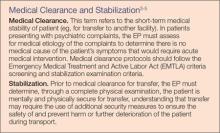Dr Mallory is a professor of emergency medicine at the University of Louisville School of Medicine in Louisville, Kentucky. Mr Knight is a senior medical student at the University of Louisville School of Medicine, Kentucky.
Two Questions to Guide the Emergency Physician’s Workup:
Are the psychiatric symptoms caused or exacerbated by an underlying medical condition?
Are chronic medical conditions stable enough to be managed within the scope of a psychiatric facility?
Case Scenarios
Case 1
A 19-year-old college freshman presented to the ED, reporting poor sleep, loss of appetite, and generalized disinterest in school. She stated that she had been unable to concentrate on studying for her midterm exams. She further admitted to having thoughts of loneliness and suicide.
Case 2
Following a relationship break-up, a 28-year-old man with a history of bipolar disorder was brought to the ED after slitting both of his wrists. He was agitated and tremulous, stating that he “wanted to die.” His medications included divalproex and lithium.
Case 3
A 52-year-old woman with a medical history of hypertension, emphysema, and schizophrenia presented to the ED, asking to see the on-call psychiatrist because she did not feel the injection of intramuscular ziprasidone she had received the previous day was controlling her hallucinations. Moreover, she believed that the medication was causing the pain she was experiencing in her left shoulder.
Overview
Already challenged by the increasing medical complexity of patients, overcrowding, limited consultation availability, measurable quality outcomes expectations, and patient safety issues, emergency physicians (EPs) are also treating an increasing number of patients with behavioral health emergencies. At least 6% of all ED visits in 2001 were attributable to a primary psychiatric presentation, with steady annual increases seen over the past decade.1 In 2010, the Agency for Healthcare Research and Quality reported that 12.5% of ED visits were related to mental disorders and/or substance abuse.2
Initial assessments, management, and consultations on patients with behavioral health presentations occur daily in every ED. As the aforementioned brief case vignettes suggest, the EP is faced with a wide variability of their clinical presentations.
Limitations and Liabilities
For centuries, psychiatrists have sought medical causes of psychiatric problems, which alone might mandate a “medical clearance” for behavioral health patients who present with new or routine exacerbations of behavioral issues. Such “psych clearance” requests are routinely expected and performed in most EDs today. Despite efforts to define the term itself (see Box), to standardize patient selection for the process and to identify the appropriate depth of testing, a definition of “routine” screening for underlying medical causes of acute psychiatric presentations remains elusive. The goals of screening may differ between specialists in psychiatry and emergency medicine, and may vary by patient demographics, local expertise, practice patterns, and the variability of medical backup for psychiatrists in stand-alone psychiatric facilities.
The term medical clearance is vague, controversial, and often misinterpreted. Since it is not possible to screen and diagnose all potential concurrent medical illnesses in the ED, some authors prefer the terms “evaluation for medical stability,” or “focused medical assessment.”6 Defining expectations and limits of such an examination, screening for medical mimics, and developing a process for clear communication between providers that includes standard documentation of care are useful in establishing system-specific evaluations of care—and in building a consensus among providers regarding diagnostic testing in the ED.6-8
The literature demonstrates that little is gained from the routine EP screening of patients in need of psychiatric care, particularly screening beyond a focused medical examination.8-15 Unfortunately, firm conclusions are difficult to reach because published studies have neither uniformly documented the same elements of the histories, physical examinations, and diagnostic testing nor have they stratified the indications for laboratory investigations by the pretest probability of underlying disease. They also have not described whether or how disposition decisions would have been altered.
While much of the literature focuses on the controversies surrounding laboratory testing and a lack of standardized guidelines in the medical clearance process, decision-making errors and human bias are also reported. Consequences of prematurely anchoring presenting medical symptoms to a patient’s known psychiatric disorder may be compounded by key assessment procedures less often performed on patients admitted to psychiatric units compared with patients admitted to medical floors.10 The increasing burden on staff time by agitated patients and ”boarders” awaiting limited inpatient psychiatric beds, personal attitudes toward suicide and substance abuse, and the operational challenges of the medical clearance process itself all may adversely affect the care of these patients.16 In fact, the issue of disparate equality of emergency care for patients with behavioral health issues as compared to emergency medicine patients with medical and surgical complaints has been raised.17 While focused emergency care has been developed and implemented for medical presentations such as chest pain and multiple trauma, the lack of similar protocols for behavioral health emergencies may explain why complete assessments of psychiatric patients’ mental status or cognitive abilities are rarely performed and documented.18

